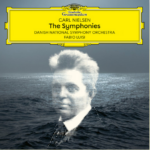This page is also available in / Cette page est également disponible en:
![]() Francais (French)
Francais (French)
In 1925, at the age of 60, Denmark’s national composer gave in to depression. ‘If I could live my life again,’ said Carl Nielsen, ‘I would … take a commercial apprenticeship or do some other form of useful work that would lead to a visible final result. The creative artist’s lot is not a happy one.’
 Nielsen was working at the time on his sixth symphony, titled ‘the simple symphony’ though it was nothing of the sort. His marriage had broken down and he was feeling unappreciated. His fifth symphony, in two movements, was packed with impotent rage. The sixth was pared down to semi-disjointed statements, enigmatic and forever unsettling. Nielsen delved deep into himself while offering limited rewards to his listeners. The ending of the sixth is a bad joke without a punchline. Nielsen is perhaps the most elusive of great composers.
Nielsen was working at the time on his sixth symphony, titled ‘the simple symphony’ though it was nothing of the sort. His marriage had broken down and he was feeling unappreciated. His fifth symphony, in two movements, was packed with impotent rage. The sixth was pared down to semi-disjointed statements, enigmatic and forever unsettling. Nielsen delved deep into himself while offering limited rewards to his listeners. The ending of the sixth is a bad joke without a punchline. Nielsen is perhaps the most elusive of great composers.
Every decade or so, a conductor attempts to make sense of the six symphonies on record. Leonard Bernstein started the trend in 1960s New York, followed by Herbert Blomstedt in San Francisco, Neeme Järvi in Gothenburg, Paavo Järvi in Frankfurt, Alan Gilbert in New York, and two or three more. None was convincing throughout. Either they oversell the early works, as Bernstein did, or (all but Neeme) they underplay the terrible confusions of the final masterpieces.
The Italian Fabio Luisi has two advantages over his predecessors on record. He is principal conductor of the Danish National Symphony Orchestra which speaks Nielsen as its mother-tongue, and he brings the skills of an opera interpreter, balancing flare-ups of passion with overall structure. Luisi’s account of the third symphony, the Espansiva, is a masterclass in managing fluctuations of mood within a coherent frame.
The next symphony, the Inextinguishable, takes reckless speeds in an open-topped car before plunging over a cliff in an Adagio of unexampled bleakness. Written during the First World War, it is probably the most performed of the Nielsen symphonies. This performance, intense and expertly played, brilliantly projected on Apple Classical, is the best I have ever heard, with the Espansiva not far behind. I emerged shaking from the fifth symphony, so fearsome was the intensity of the Danish playing and the total absence of optimism. If you have any doubts at all about Carl Nielsen’s genius, start with the slow movement of the fourth symphony and work outwards. This enterprise is a true rarity on record in the 21st century, an epochal set that will last the test of time.
This page is also available in / Cette page est également disponible en:
![]() Francais (French)
Francais (French)














